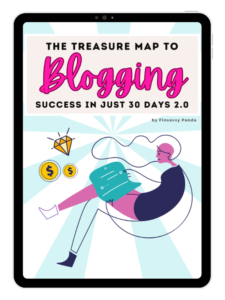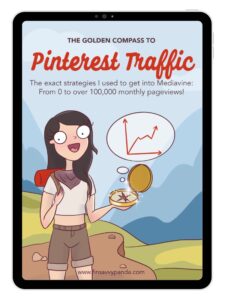
If you’ve ever wondered how to make money with a website, you are in the right place.
Creating a website and turning it into a profitable venture can be one of the most rewarding experiences in the digital world.
As a full-time blogger who has navigated the digital monetization landscape, I’m here to share practical insights and actionable strategies that can help you turn your website into a profitable venture.
Whether you’re just starting or looking to optimize your current site, this practical guide will help you discover strategies to make money with a website.
12 WAYS TO MAKE MONEY WITH A WEBSITE
1. CHOOSE YOUR NICHE
One of the first steps in creating a profitable website is choosing the right niche. This decision will shape your content, attract your target audience, and ultimately determine your success. When selecting a niche, consider your interests, market demand and competition.
Importance of Selecting a Niche
Your niche should be something you are passionate about. Selecting a niche helps you attract a dedicated audience and establish yourself as an authority in that area.
It is essential to choose a niche that interests you, has market demand, and isn’t overly saturated with competition.
When I started my blogging journey, I spent a lot of time researching and contemplating various niches. Here is what I found essential:
Interest
Passion fuels persistence. Choose a niche that excites you, as you’ll be spending a significant amount of time creating content around it. Your enthusiasm will resonate with your audience, making your website more engaging.
Market Demand
Conduct keyword research to gauge the demand for your niche. Tools like Google Keyword Planner, Ahrefs, and SEMrush can help you identify high-volume keywords and trending topics within your chosen niche.
Competition
A competitive niche isn’t necessarily a bad thing; it means there’s money to be made. Just ensure you can offer a unique perspective or better value. Look for gaps you can fill.
Some profitable niches include personal finance and money matters, health and wellness, technology, lifestyle and travel, self-improvement, food and recipes.
Once you have chosen your niche, it’s time to build a high-quality website.
2. BUILD A HIGH-QUALITY WEBSITE
Your website is your digital storefront. It needs to be attractive, user-friendly, and functional to keep visitors engaged and coming back.
Here are the key steps to building a high-quality website:
Choosing a Domain Name and Hosting Service
Your domain name should be easy to remember, easy to spell, and reflective of your niche.
Use services like Bluehost, SiteGround, or HostGator for reliable hosting solutions that ensure your site runs smoothly.
Website Design and User Experience

Invest in a professional, visually appealing clean design. Platforms like WordPress offer customizable themes that cater to different niches.
Prioritize user experience by ensuring easy navigation, fast load times, and a responsive design that looks great on all devices.
Mobile Responsiveness
With more people accessing websites via mobile devices, ensure your site is mobile-friendly. This not only improves user experience, but Google also ranks mobile-responsive websites higher in search results.
Ensure your site loads quickly and is mobile-responsive since many users access websites via their smartphones.
Key Elements
Include essential pages like About, Contact, and a Blog section. The About page builds trust by sharing your story and expertise.
The Contact page provides visitors with ways to reach you, enhancing credibility.
The Blog section allows you to regularly publish valuable content, keeps visitors engaged and coming back.
3. CREATE VALUABLE CONTENT
Content is king. The quality and relevance of your content will attract visitors, keeps them engaged, and encourage them to return.
Here’s how to create content that resonates:
Understanding Your Audience’s Needs
Know your audience. Understand their pain points, interests, and what type of content they prefer.
Use tools like Google Analytics and social media insights to understand your audience’s demographics, behavior, and gather data.
This information helps tailor your content to their needs.
Types of Content
Diversify your content by including blog posts, videos, podcasts, infographics, and downloadable resources.
This variety caters to different preferences and keeps your audience engaged.
Consistency in Content Creation
Create a content calendar to plan your posts and stick to a regular posting schedule.
Consistency builds trust and encourages repeat visits.
Aim to publish at least one high-quality post per week.
SEO Basics

Optimize your content for search engines to increase organic traffic.
Use targeted keyword research to identify relevant terms and phrases, then incorporate them naturally into your titles, headers, and body text.
Also, optimize meta descriptions, use alt tags for images, link to other posts on your site to improve navigation and SEO.
Ensure your content is easy to read, informative, and answers the search intent behind the keywords.
4. IMPLEMENT AFFILIATE MARKETING
Affiliate marketing is one of the most popular ways to monetize a website. It involves promoting products or services and earning a commission for every sale made through your referral link.
Explanation of Affiliate Marketing
As an affiliate, you partner with companies and promote their products on your website. When a visitor clicks on your affiliate link and makes a purchase, you earn a commission.
How to Find Affiliate Programs
Join affiliate networks like Amazon Associates, ShareASale, or Commission Junction. Look for products and services relevant to your niche that offer competitive commissions.
Tips for Integrating Affiliate Links Naturally
Write product reviews, comparison posts, or create tutorials where you can include links to the products you recommend.
Avoid overloading your posts with affiliate links. Instead, incorporate them seamlessly to maintain a natural flow.
Best Practices to Avoid Spamming
Disclose your affiliate relationships to maintain transparency and trust with your audience.
Use calls-to-action (CTAs) to encourage clicks, and regularly update your links to ensure they remain active.
Focus on providing value, and only recommend products you genuinely believe in.
5. USE DISPLAY ADVERTISING
Display advertising involves placing ads on your website and earning revenue based on impressions (views) or clicks.
Overview of Display Advertising
Display ads can include banner ads, sidebar ads, and in-content ads. They are a passive income stream, requiring minimal maintenance once set up.
Platforms like Google AdSense and Media.net allow you to display ads on your website and earn money based on clicks or impressions. It matches ads to your site based on your content and visitors.
Setting Up and Managing Ads
Sign up for an ad network like Google AdSense or Media.net. Once approved, you can place ad units on your site, and customize the ad placements. Monitor your performance through the network’s dashboard and adjust as necessary. Use tools like Ad Inserter to manage ad placements effectively.
Maximizing Ad Revenue
Experiment with ad placement to see what performs best. Generally, ads placed above the fold (visible without scrolling) and within content tend to perform better.
Limit the number of ads to avoid cluttering your site and compromising user experience.
Balancing User Experience
While ads can be lucrative, prioritize your audience’s experience. Too many ads can drive visitors away. Ensure that your ads complement your content, aim for a balance that ensures a pleasant user experience while generating revenue.
6. SELL DIGITAL PRODUCTS

Creating and selling digital products is a lucrative way to monetize your website. Digital products have low overhead costs and can be sold repeatedly without inventory concerns.
Types of Digital Products
Consider creating e-books, online courses, printables, templates, and software. Choose products that align with your niche and solve a problem for your audience.
Creating and Pricing Your Digital Products
Identify what your audience needs and create products that provide value. Invest time in creating high-quality products.
Use tools like Canva for design, Teachable for online courses, and Gumroad for digital sales.
Price your products competitively by researching similar offerings and considering your audience’s willingness to pay.
Offer discounts or bundles to attract more buyers.
Setting Up an Online Store
Platforms like Shopify and WooCommerce make it easy to set up an online store. They provide the tools you need to manage inventory, process payments, and handle customer service.
These platforms offer user-friendly interfaces and various customization options to match your brand.
For example, WooCommerce integrates seamlessly with WordPress. Here’s how you can get started:
Install the Plugin: download and install WooCommerce or any other e-commerce plugin of your choice.
Add products: upload your digital products with detailed descriptions and attractive images.
Set up payment gateways: integrate payment options like PayPal, Stripe, or direct bank transfers.
Optimize your store: ensure your store is user-friendly and mobile-responsive.
Marketing Your Products
Promote your digital products through your website, blog posts, social media, email marketing, and collaborations with influencers.
Highlight the benefits and value your products offer to encourage purchases.
Offer limited-time discounts and engage with your audience to boost sales.
7. OFFER PAID MEMBERSHIPS OR SUBSCRIPTIONS
Paid memberships or subscriptions provide exclusive content or services to members, generating recurring revenue. This model works well if you have exclusive content or services to offer.
Benefits of a Membership Site
Membership sites foster a sense of community and loyalty. Members feel valued and are more likely to engage with your content.
Members pay a recurring fee for access to exclusive content, services, or products.
Types of Content/Services
Offer exclusive articles, videos, premium courses or webinars, one-on-one coaching or consultation, or access to a private community.
Tailor your offerings to meet the needs and interests of your audience.
Tools for Setting Up Memberships
Platforms like Patreon, MemberPress and Restrict Content Pro make it easy to create and manage membership sites.
They offer features like tiered membership levels, payment processing, and content access control.
Pricing Strategies
Research your audience to determine a fair price. Offer multiple membership tiers with varying benefits to cater to different budgets.
Provide a compelling value proposition for each tier to encourage sign-ups.
8. PROVIDE SERVICES
Offering services through your website can be highly profitable, especially if you have specialized skills.
List of Possible Services
Consider offering consulting, freelance writing, graphic design, web development, SEO services, or virtual assistance. Choose services that align with your expertise and niche.
Marketing Your Services

Create a dedicated ‘Services’ page outlining what you offer, your expertise, and testimonials from satisfied clients.
Use blog posts, SEO and social media to showcase your skills and attract potential clients.
Utilize forms or booking systems to make it easy for potential clients to reach you.
Creating a Portfolio or Case Studies
Showcase your previous work and success stories to build credibility. A ‘Portfolio or Case Studies’ page can help potential clients see the value you offer.
Setting Up a Booking or Contact System
Use tools like Calendly or a simple contact form to make it easy for potential clients to reach out and schedule consultations.
Utilize plugins like Contact Form 7, Calendly, or WPForms to set up an easy-to-use booking or contact system on your website.
9. SPONSORED CONTENT AND PARTNERSHIPS
Sponsored content and partnerships involve collaborating with brands to create content that promotes their products or services.
Partnerships can also include collaborations or joint ventures.
Explanation of Sponsored Content
Sponsored content can include blog posts, articles, social media posts, reviews, videos, or podcasts created in collaboration with a brand.
You receive compensation for promoting their offerings.
Attracting Sponsors
Build a strong following and demonstrate engagement on your website and social media.
Brands look for influencers with a loyal and active audience.
Don’t wait for brands to come to you, pitch your ideas and explain how you can provide value to them.
Creating a Media Kit
A media kit is a document that showcases your website’s traffic statistics, audience demographics, past collaborations and the types of sponsored opportunities you offer.
It helps potential sponsors understand the value you provide. It also showcases your professionalism and makes it easier for brands to decide to work with you.
Negotiating Deals and Contracts
Clearly outline the terms of the collaboration, including deliverables, payment terms, content ownership, and timelines. timelines, and compensation.
Ensure all agreements /contracts are in writing to formalize agreements and protect both parties’ interests.
10. EMAIL MARKETING

Building an email list is one of the most valuable assets for your website. It allows you to communicate directly with your audience and promote your content, products, and services.
Importance of Building an Email List
Email marketing has a high return on investment (ROI). An email list is a direct line to your audience, free from the fluctuations of social media algorithms.
It is a direct channel to your audience where you can promote your content, products, and services directly to their inbox.
It enables you to build relationships, drive traffic, and generate sales.
Tools for Email Marketing
Use platforms like Mailchimp, ConvertKit, or AWeber to create and manage your email list. These tools offer features like automation, segmentation, and analytics to optimize your campaigns.
Strategies for Growing Your List
Offer incentives like free e-books, checklists, discount codes or exclusive content in exchange for email sign-ups.
Promote your opt-in forms on your website, blog posts, and social media channels. Encourage people to join your list by offering the chance to win a prize.
Monetizing Through Email Marketing
Use your email list to promote your products, affiliate offers, special offers or discounts and sponsored content.
Create engaging newsletters that provide value and encourage clicks. Create automated email sequences (sales funnels) that guide subscribers toward making a purchase.
11. E-COMMERCE AND DROPSHIPPING
E-commerce and dropshipping allow you to sell physical products through your website without the need for inventory management.
Setting Up an Online Store
Platforms like Shopify and WooCommerce make it easy to set up an online store.
These platforms provide all the tools you need to manage products, process payments, and handle shipping.
Ensure it is user-friendly and optimized for conversions.
Choosing Products to Sell
Conduct market research to identify products that resonate with your audience. Consider factors like demand, competition, and profit margins.
Use tools like Google Trends and keyword research to identify trending products. You can start with a few products and expand as you learn what sells best.
Dropshipping Basics
With dropshipping, you partner with suppliers who handle inventory and shipping. You market and sell the products, and the supplier fulfills the orders.
When a customer makes a purchase, the order is fulfilled by a third party and shipped directly to them. This model reduces upfront costs and inventory risks.
Marketing Your E-commerce Site
Use SEO, social media marketing, and paid advertising to drive traffic to your store.
Highlight the benefits and unique selling points of your products to attract buyers.
Utilize email marketing to notify subscribers of new products and special offers.
12. UTILIZE SOCIAL MEDIA
Social media is a powerful tool for driving traffic to your website and engaging with your audience. It can also be a significant revenue stream through ads, sponsored posts, and direct sales.
Leveraging Social Media to Drive Traffic
Choose platforms that align with your niche and audience. Share your content on platforms like Facebook, Instagram, Twitter, and Pinterest.
Use hashtags, engaging captions, and high-quality images to attract attention. Engage with your followers by responding to comments and messages.
Creating Shareable Content
Create content that resonates with your audience and encourages them to share it.
This can include infographics, videos, quotes, and blog posts.
Use high-quality images, engaging videos, and compelling headlines to capture attention.
Using Social Media Ads
Run targeted ads on social media platforms to reach a wider audience.
Platforms like Facebook Ads and Instagram Ads offer targeting options to ensure your ads reach the right people.
Use analytics to track performance and optimize your campaigns.
Engaging with Your Audience
Respond to comments, messages, and mentions to build relationships with your followers.
Host live sessions, Q&A sessions, and giveaways to boost engagement. Asking for feedback can increase engagement.
Building a strong connection with your audience can lead to increased loyalty and more sales.
CONCLUSION ON HOW TO MAKE MONEY WITH A WEBSITE
Monetizing a website is a journey that requires patience, persistence, and continuous learning.
By choosing the right niche, creating valuable content, and leveraging various monetization strategies, you can turn your website into a profitable venture.
I am confident that with these insights and strategies, you will be well on your way to making money with your website.
Start implementing these strategies today, and don’t hesitate to experiment and find what works best for you.
Good luck on your journey to making money with your website!
I hope you found this article helpful and insightful. Kindly share and follow me on Pinterest and LinkedIn for the latest posts.
 ABOUT CHRISTY MICHAEL
ABOUT CHRISTY MICHAEL
I am passionate about finding creative ways to pay off debts, make more money, and save more money; and helping people achieve their financial goals and ultimately, financial freedom. My journey of overcoming consumer debts and achieving financial independence inspired me to start FinanceWit.org (with no knowledge or experience with blogs). FinanceWit is a personal finance and money matters blog, where I share a treasure trove of tips, tricks, and innovative strategies to fast-track your journey to debt freedom. Want to dive deeper into my story? Read more about me here.


